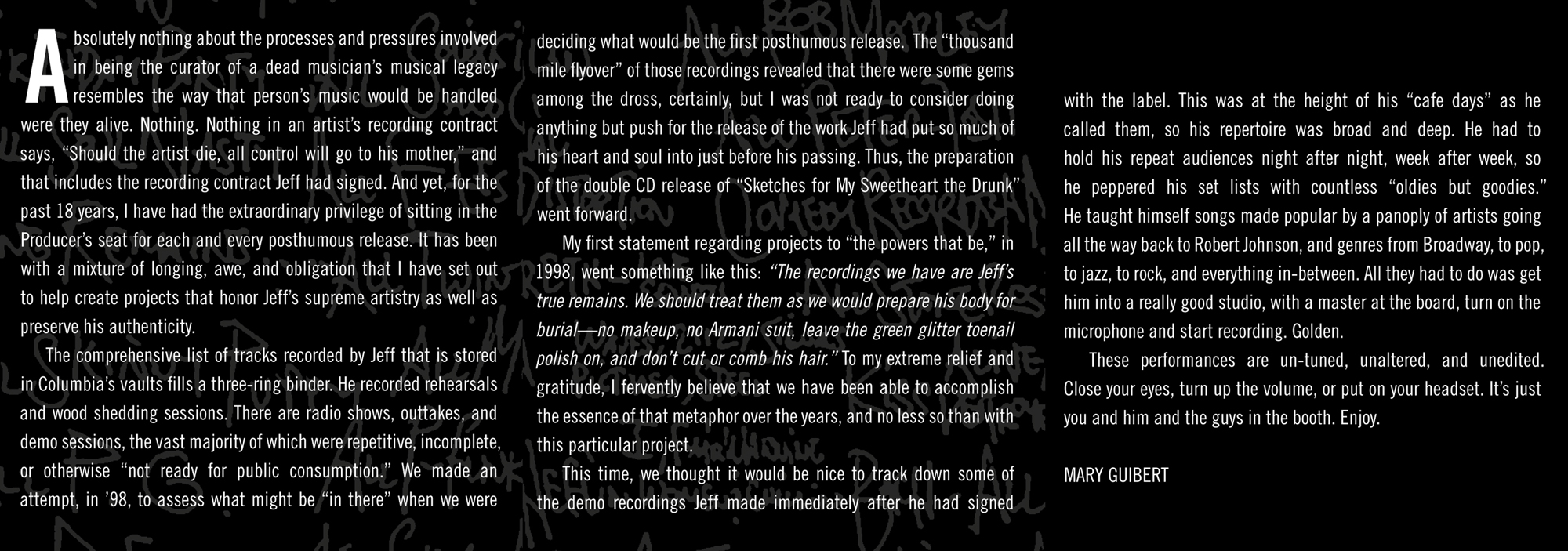Absolutely nothing about the processes and pressures involved in being the curator of a dead musician’s musical legacy resembles the way that person’s music would be handled were they alive. Nothing. Nothing in an artist’s recording contract says, “Should the artist die, all control will go to his mother”, and that includes the recording contract Jeff had signed. And yet, for the past 18 years, I have had the extraordinary privilege of sitting in the Producer’s seat for each and every posthumous release. It has been with a mixture of longing, awe, and obligation that I have set out to help create projects that honor Jeff’s supreme artistry as well as preserve his authenticity.
The comprehensive list of tracks recorded by Jeff that are stored in Columbia’s vaults fills a three-ring binder. He recorded rehearsals and wood shedding sessions. There are radio shows, outtakes, and demo sessions, the vast majority of which were repetitive, incomplete, or otherwise “not ready for public consumption”. We made an attempt, in ’98, to assess what might be “in there” when we were deciding what would be the first posthumous release. The “thousand mile flyover” of those recordings revealed that there were some gems among the dross, certainly, but I was not ready to consider doing anything but push for the release of the work Jeff had put so much of his heart and soul into just before his passing. Thus, the preparation of the double CD release of Sketches for My Sweetheart the Drunk went forward.
My first statement regarding projects to “the powers that be”, in 1998, went something like this: “The recordings we have are Jeff’s true remains. We should treat them as we would prepare his body for burial –no makeup, no Armani suit, leave the green glitter toenail polish on, and don’t cut or comb his hair.” To my extreme relief and gratitude, I fervently believe that we have been able to accomplish the essence of that metaphor over the years, and no less so than with this particular project.
This time, we thought it would be nice to track down some of the demo recordings Jeff made immediately after he had signed with the label. This was at the height of his “cafe days” as he called them, so his repertoire was broad and deep. He had to hold his repeat audiences night after night, week after week, so he peppered his set lists with countless “oldies but goodies”. He taught himself songs made popular by a panoply of artists going all the way back to Robert Johnson, and genres from Broadway, to pop, to jazz, to rock, and everything in-between. All they had to do was get him into a really good studio, with a master at the board, turn on the microphone and start recording. Golden.
These performances are un-tuned, unaltered, and unedited. Close your eyes, turn up the volume, or put on your headset. It’s just you and him and the guys in the booth. Enjoy.
MARY GUIBERT


